The King Is Dead, Long Live The King: How Ilia Topuria Executed Alexander Volkanovski
An Extended Study of Ilia Topuria's Greatest Masterpiece
One thousand, five hundred and twenty seven days.
Alexander Volkanovski is a special talent, a fighter unlike any seen before and, for this writer’s money, unlike any we will see again. Not only dominant and athletic but uniquely cerebral, Volkanovski’s kingship was one defined by ruthless, tactical beatdowns.
Ilia Topuria, full of the confidence an undefeated 27-year-old should have, marched up to the castle walls as so many had before. What separated Topuria from his predecessors, though, was a complete dismissal of the threat Volkanovski posed and an entirely unearned, but seemingly genuine, confidence.
Although Topuria had looked impressive against power-hitter Josh Emmett, it was hard to use the 38-year-old banger-boxer as a marker for success against a striker of Volkanovski’s prestige, let alone in handling the champion’s tactical chops. This would be a trial unlike anything he’d come close to facing before.
As the would-be usurper stood across from the best Featherweight who ever lived, the world stood still.
Kicking High: Traps, Counters and Kicking The Power Hand
The bout itself would be short, but overflowing with beauty. Volkanovski’s plan was clearly drawn with 25 minutes in mind, doing his best to stifle the Georgian-Spaniard over the course of his first championship fight. Topuria made no such long-term arrangement, investing in an approach that would see him lose minutes but force Volkanovski to dance upon a knife edge until he could dance no more.
The least surprising weapon that Volkanovski brought to the field was an emphasis on lead-leg high kicks. Topuria’s only actual moment of vulnerability thus far came, surprisingly, at the foot of unranked and undecorated Jai Herbert. Up a division at Lightweight, Topuria found himself on the receiving end of a counter-left high-kick that set him down momentarily. Topuria would end Herbert’s success shortly after, but it served to show a moment of vulnerability in the young man’s defences.

Volkanovski is not one to allow such defensive errors to go unpunished, and whilst Topuria had certainly patched up his defence against Emmett, the tendency would still make an appearance regularly enough to exploit. Volkanovski would not be content to let his opponent’s mistakes come naturally and quickly took the initiative in baiting Topuria’s right hand away from his face.

In theory, this did several things for Volkanovski. Most simply, it established Volkanovski’s jab as more than just a punch, but also an entry into more dangerous weapons. Topuria couldn’t be entranced by Volkanovski’s jabs because behind them lay not only shinbones but an ever-expanding arsenal of weapons.
Alongside this, kicking at Topuria’s rear side punished Topuria for taking his rear power hand away from his head, as he would need in order to throw it. This is a strategy as old as time when facing fighters with power in their hands, keeping their rear weapon impotent and pinned tightly with a barrage of offence to that side. In a best-case scenario for Volkanovski, the puncher decides to bite down and throw, resultingly clipped like Topuria against Herbert. Worst case, they take his leg against their power hand.
At the risk of stating the obvious, this hurts and makes the puncher a lot more reluctant to load energy through their swollen, bruised limb. This principle dovetails wonderfully to the idea of drawing Topuria’s right hand away; just as it hurts to fire a damaged arm, so too does it ache to keep it raised in a defensive guard. As the fight drew into the championship rounds and Topuria’s right hand took greater punishment, it wouldn’t be unthinkable that Topuria’s defense could fall apart and set up a coveted finishing sequence for the champion.
Most specific to Volkanovski, though, is that his high kicks simply made it easier for him to jab. By opening the fight with a declaration of “I’m going to kick your head on this side” Volkanovski established the dangers of parrying his jab. If Topuria wasn’t parrying, Volkanovski’s job in jabbing it was significantly easier. If Topuria then decided to rely on his head movement to slip the jab, he places himself at greater risk of slipping into a kick.
Of course, Volkanovski would also to counter with the kick as Herbert did. On Topuria’s boxing entries, Volkanovski would lean his body backward and bring up his lead kick with ambitions of catching Topuria mid-swing.


Given an Inch, Taking A Mile: Volkanovski and the Left Hook
Volkanovski used his left hook in much the same way as his kicks, slapping it around when Topuria’s right hand dropped to punch or parry. This proved a much better tool when Volkanovski was on the move, able to circle out behind the hook rather than having to plant as with a kick.



One of the more significant sequences saw Volkanovski utilise a variant of this, instead switching to Southpaw and landing a crashing left hand as Topuria entered.

From this intermittent switch-hitting, Volkanovski built into the same shifting combination that was a lynchpin in his first bout against Islam Makhachev.
The above sequence shows a lot of both men’s best traits, especially considering how risky of a combination this is. Volkanovski first fires his southpaw left hand across to catch Topuria’s left dip. Topuria reads this and weaves to his right beautifully as Volkanovski falls into space. Volkanovski lines Topuria up with a left hook and clips a (now rear) right hand across Topuria’s frame.

Volkanovski’s approach to Topuria’s low right hand was varied and by far the most effective idea he had in this bout with Topuria. It was both the concept and the wide arsenal through which he exploited this hole that kept Volkanovski winning the minutes against Topuria, even when he was dealing with Topuria’s pressure and combinations.
The Good and The Bad of Alexander Volkanovski’s Jab
When not attacking Topuria’s low right hand, Volkanovski’s ideal was to trust in his ever-formidable jab, oftentimes feinting it or throwing it as a smokescreen to keep his opponents at a comfortable range. Against Topuria, he found it getting him into trouble almost immediately as Topuria tried to establish his own set of rules in this fight. Volkanovski was not to control the space; El Matador was.

By re-contextualising Volkanovski’s lead probes as opportunity rather than limitation, Topuria was able to consistently keep his pressure upon Volkanovski throughout. Volkanovski might jab and probe Topuria back at times but they never kept him at bay for long.
Above is Volkanovski’s pressure at its best. Zombie reacts to every single feint, giving ground to avoid whispers and twitches from the champion. Zombie fires back to claw back some agency but presents Volkanovski with the same reaction he’s panning for. Volkanovski punts Zombie’s lead leg, brought out of stance on his jab.
Now contrast Zombie and Topuria’s responses. Topuria isn’t ignoring Volkanovski’s offerings, but he’s refusing to fight as if in fear of them. He might briefly pause his advance or take a half-step out of range. He might bat away Volkanovski’s offerings, or even take a bit of punishment in exchange for his advance, but he never lets Volkanovski take over as Zombie did, and this relationship with Volkanovski’s lead hand was integral to Topuria’s victory.

The above sequence shows how Volkanovski was able to find moments of success with his white noise leads, but not close to how he was able to tie previous opponents in knots.
Volkanovski did find his jab in Round 2, though, as a counter to Topuria’s entries rather than as a proactive tool of his own. He was oft able to stop Topuria in his tracks, alleviate pressure, reset and find offensive tools of his own.


It’s important to note that Volkanovski didn’t abandon his pressuring feints and throwaway jabs. Keeping them in play was important even if Topuria didn’t respect them as much as his predecessors, as they yielded a useful first layer from behind which Volkanovski’s meaningful strikes emerged, particularly drawing Topuria into left hooks. As Volkanovski became more comfortable punching with Topuria into Round 2, his offensive jabs grew that much more potent as Topuria was forced to contend with a range of weapons rather than simply jabs and lead kicks.
Volkanovski Kicking Low
It’s hard to imagine Alexander Volkanovski without his low kicks. Alongside his jab, it is the seed from which the rest of his striking sprouts.
That being said, to kick Ilia Topuria’s legs would be part of almost any elite opponent’s strategy. With a style heavily influenced by the boxing world, Topuria stands heavy. This enables his signature upper-body movement, standing based in order to slip and roll his opponent’s offence. Not only this, but his heavy stance allows Topuria to find his showstopping power rather than sacrificing it for greater mobility a la Volkanovski.
Punishing Topuria’s head movement relied first on Volkanovski establishing his boxing. If Topuria became accustomed to slipping, as he often does, he could be baited into slipping throwaways. As Topuria set himself to slip, he’d present his leg on a platter; a prime target for the champion. The below sequence showcases this:

Topuria’s reaction is tell enough of how he felt about this. He instantly starts to pick up his lead foot and backs away from Volkanovski’s advance.
Volkanovski’s low kicks also proved an interesting counter to Topuria’s blitzes. This was a high-risk, high-reward strategy as it required Volkanovski to be in position to kick on the backfoot, a hard enough task without standing across from one of the best offensive cagecutters in the sport.
Volkanovski exited outside of Topuria’s right hand often, planting himself a hair’s breadth out of danger and swinging his lead leg into Topuria’s own. This caught Topuria out of stance, leaning over his front leg at the peak of his vulnerability.
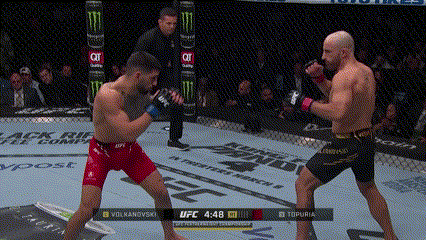

Dedicated low kicks were smart from Volkanovski, attacking Topuria’s lead leg during moments when it bore weight. This, in time, might have limited Topuria’s movement which was so integral to this particular gameplan as he aimed to outmaneuver and launch into combinations against Volkanovski. With compromised legs, these ideas would become infinitely harder to execute. Despite this, Topuria did well to hide his reactions, rarely if ever showing instability or limping.
What gave him away, though, were his reactions when kicked. We’ve noted already how Topuria backed away when Volkanovski kicked him, giving up the ground he’d worked so diligently to take away from the champion. Topuria’s reactions would only grow more exaggerated, at one point leaping into the air like a startled cat.

Running Feedback: Ilia Topuria’s Anti-Kicking Agenda
Despite everything written above, Topuria did an excellent job at minimising the impact of Volkanovski’s kicks.
The most basic of Topuria’s anti-kicking tactics was a simple calf kick defence, to pull back one’s leg. To do this without losing ground and upsetting his stance, Topuria pulled his lead leg back whilst keeping his rear foot planted.

This adjustment allowed Topuria to maintain pressure whilst putting Volkanovski in a vulnerable position, on the back foot and on one leg. As Volkanovski was forced to reset, Topuria tooks the initiative and chases him down.
Besides the standard defence, Topuria decided that the best way to disrupt Volkanovski’s kicking was to simply make himself hard to counter, given Volkanovski’s penchant for counter kicking. Upon baiting a mistake from Volkanovski, or hypnotising him with fake entries, Topuria would enter for real and fire off his boxing combinations.
Volkanovski had no intention of making this easy though. Topuria had a tough time with this approach early, faking one or two entries before committing to the real thing. These was ineffective in making Volkanovski commit, drawing inconsistent and minor reactions. All the more, Volkanovski was still primed and ready to counter Topuria’s real entries with his kicking. A lot of Topuria’s early offence was stepping into Volkanovski’s kicks and glancing his fists upon Volkanovski’s shoulders.
How Topuria managed to genuinely upset Volkanovski was by increasing the frequency of his fakes. By faking at great volume, Volkanovski found it much harder to time Topuria’s real entries. See below, as Topuria fakes several times before committing to his strikes:
Here we can see the various ways in which Topuria effectively fakes Volkanovski out. Firstly, he leans over to his left and shoulder-feints his overhand right. Next, he takes a deep step towards Volkanovski which also threatens the overhand (or body shots). Topuria probes at Volkanovski’s lead right hand with his own lead left, a simple way of making Volkanovski dance to the rhythm of El Matador. Topuria takes a few smaller steps before entering high and low with two jab feints and then commits to his dedicated combination.
It doesn’t matter that Topuria fails to land his committed shots here; he managed to avoid the counter-kicking simply by making himself harder to read.
Breaking Rhythm: Topuria’s Disruptive Body-Jab
Volkanovski’s response was to take back the initiative. By getting more active, particularly with his punching, he refused to let Topuria have the space to play with long sequences of fakes and feints. These were certainly Volkanovski’s moments of greatest success.
Topuria, forced to contend with a sparser and thus less predictable, kicking approach, tried a new tack. Instead of entering every committed exchange with the goal of landing his warhead of a right hand, he opted to ease off of the accelerator and instead open some exchanges with a simple jab, often to the body. This worked wonders for Topuria, lancing the champion’s oft-kicking, squared body. Catching Volkanovski’s body on one leg could also unbalance Volkanovski, forcing a significant retreat and allowing Topuria to chew up even more ground.
By not committing so hard to every single counter opportunity, Topuria’s combinations found their mark with greater frequency. Volkanovski could no longer predict Topuria’s intent, with no reliable right hand to build upon.

A Quick Word on Ilia Topuria’s Begrudging Kicks
Topuria’s own game wasn’t void of kicks, although stilll tacked onto the Spaniard’s offence in contrast to the depth he brings to his boxing He therefore limited his kicks to Volkanovski’s calf, spinning the champion like a Beyblade off of a jab at one time..
This dynamic didn’t last longer than two successful attempts, as Volkanovski quickly became wise to it and shortened his stance as Topuria had himself when low kicked. The threat of the calf kick did continue to back Volkanovski up, but when thrown the result was often a Volkanovski net positive.

Boxing in Combination: Ilia Topuria’s X Factor
As kicking was the beating heart of Alexander Volkanovski’s gameplan, boxing was Ilia Topuria’s. Specifically, Topuria chose to utilise extended combinations to overwhelm Volkanovski’s consistently knife-edge defence.
Topuria’s effective offence was born from his pressure. Putting Volkanovski on the backfoot not only put strain on the former champion’s ability to kick but also pushed Volkanovski into a corner where he’d struggle to dart out of the way of Topuria’s venom.
Once Topuria was satisfied in outpositioning Volkanovski, he would open up. In the early going Topuria utilised a simple one-two with little success, as Volkanovski simply slipped outside and circled away, making Topuria impotent in any desire to extend further.
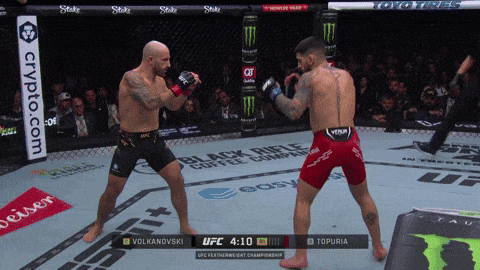
In this instance, Volkanovski angles and finds just enough space to have the punch glance off of his guard, but the theory is sound in punishing Volkanovski’s defence.

Once again, this falls short because Topuria hasn’t successfully cut Volkanovski off. In the centre of the cage, the Australian has the space to pull and circle freely away from the combination
The below sequence shows Topuria’s first successful extension and likewise his first impactful land. Whilst the sequence itself isn’t much to wax poetic for, it does shed light on the plan to punish Volkanovski’s tendency to lean and retreat defensively. Topuria’s continued chase with crowding punches refuses to let Volkanovski reset and finally catches him when the champion’s back hits the cage.


Topuria loses this exchange, landing nothing of his own and getting countered by Volkanovski’s aforementioned hook, but that isn’t the point. By continuing that particular sequence after Volkanovski had declared victory, he manages to catch the champion off-guard and compromises both his defensive reactions and his footwork . It may not have won the war this time, but it’s a textbook example of why Topuria wants to work in combinations of three and four against Volkanovski.

In the above clip, Topuria doesn’t land his overhand and does get bopped by a Volkanovski return, however insubstantial. Topuria’s real artistry is in his ability to keep pressure without making himself a target. Topuria pulls his head back on Volkanovski’s jab to lessen the impact, then bounces out to his right as a reset that still cuts off Volkanovski’s exits. On Volkanovski’s next jab Topuria dips and pulls away only slightly before launching into his finishing flurry.
In the instances where Topuria couldn’t extend a sequence to Volkanovski’s detriment, he would attack single punches simply to interrupt the champion’s rhythm.
Let us revisit the above sequence, where Volkanovski is busy working Topuria with his kicks. As Topuria lost his footing and leapt back across the cage, the champion was undeniably leading this dance.
The Spaniard changed the tune on Volkanovski with a single punch counter to the champion’s jab, a right-hand threat that forced Volkanovski onto the defensive behind a shoulder. Topuria, recognising this shift, immediately set to stalking his prey and snatched momentum back.
Blanketing The Flurry: Alex Volkanovski in The Clinch
In response to the vicious crashing combinations, Volkanovski would attempt to stifle his challenger with a clinch. This is not new to the Australian; his third and most dominant outing against Max Holloway saw Volkanovski use his clinch to break the rhythm against Holloway.
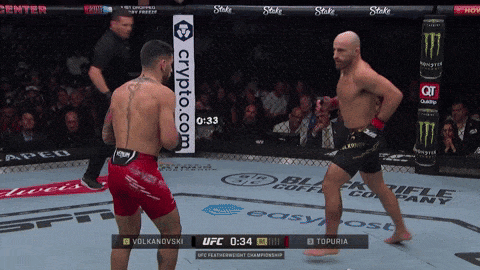

Volkanovski’s clinchwork was an imperfect failsafe, and whilst it may have served to stifle Topuria’s momentum and force resets, it left him vulnerable as a fast-twitch, kick-heavy, movement-based fighter dealing with a stocky colossus whose ideal is to be right on top of his man. His reliance on the clinch when completely cornered was part of what allowed Topuria to set up and land his killing blow.
Tying The Noose: Bringing It Together To Finish
As a writer, I try to avoid the temptation to indulge in a finishing sequence simply because it’s the climax. Often, a finishing sequence won’t speak to the wider dynamics of the fight, and will just be a moment of the right thing landing well, or one particular technique shining.
What makes Topuria’s execution of Volkanovski so intoxicating is that almost everything that both men did was in service of the moment. The kicks, the jabs, the clinch and the crashing combinations; all were instrumental in cornering and felling the all-time great champion.
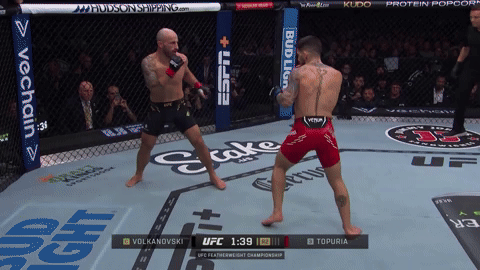
Note Topuria’s reaction to each jab. Whilst the first lands, the second he uses to attempt a counter and stifles Volkanovski’s attempt to circle out. Backed against the cage now, Volkanovski’s third jab is slipped outside subtly, allowing Topuria to retain position and spring into his finishing flurry.
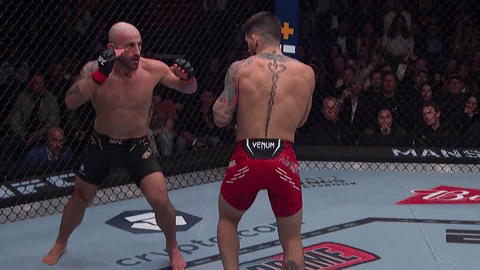
Topuria’s anticipation of Volkanovski’s clinch is just special, an adjustment akin to Volkanovski’s own mid-fight strategies. As Volkanovski’s left comes to clasp the collar tie, Topuria’s own left hand frames and he angles out to his right. This prevents Volkanovski from smothering Topuria chest-to-chest and instead allows El Matador to generate the motion necessary for his killing blow. The right hand sends Volkanovski to the land of wind and ghosts; the left is simply academic.
The New King and The Old: What Now?
As Ilia Topuria looks to defend his title against yet another all-time great in Max Holloway, he faces his toughest matchup. Holloway is lengthy, a jabber, a kicker, a superb gameplanner and holder of perhaps the greatest chin in the sport. If you were to tailor-make a man to fell Featherweight’s young king, he would look a lot like Max Holloway.
And yet it’s hard to shake the feeling that Ilia Topuria is here to stay, at least for now. Perhaps it’s the precedent of those who came before him. Featherweight has always been a division led by the greatest in the sport, with Jose Aldo and Conor McGregor alongside the aforementioned Max Holloway and Alexander Volkanovski as the division’s only champions. It feels only right to see Topuria, as the man who toppled a great such as Volkanovski, earn himself a similar reputation.
Topuria, of course, does have his own exploitables to play with. Despite his domination win over Justin Gaethje, Holloway has always struggled when he faces hitters. Volkanovski himself gave Holloway fits with his right-hand leads, and Holloway has never been nearly as elusive as the Australian. It’s hard to dispell images of Topuria landing similarly if Holloway fails to discourage him.
Whether we see the return of the old king, spurned from his throne for so long or whether the new royal retains, Ilia Topuria has enshrined himself in the history books as the man to finally depose the legend that was Alexander Volkanovski.
As for Volkanovski himself, it remains to be seen. A long break is encouraging after two brutal knockouts back to back, but the title picture has never been the place for a 35-year-old Featherweight. He looked no slower, no less able against Topuria and he may indeed continue to be competitive as an anomaly in the division. He’ll have another title shot, surely, as a decorated former champion. With a win or a loss, though, what more is there for Alexander Volkanovski?
As the paths of El Matador and The Great diverge, as the belt changes hands, we bare witness to what truly does feel like the changing of the guard in a way unique to the UFC’s Featherweight division and its impeccable standards of greatness. Topuria has legendary shoes to fill, andall the potential with which to fill them.
The Volkanovski Era is at a close, and the Unknown Age of Ilia Topuria has begun.
Two Hundred and Fifty Two days… and counting?










Just finished reading! This is a great piece, well done Ollie
Excellent work!